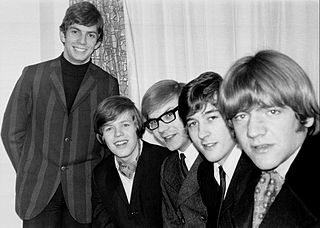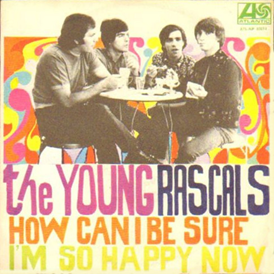
Herman's Hermits are an English rock and pop group formed in 1963 in Manchester and fronted by singer Peter Noone. Known for their jaunty beat sound and Noone's often tongue-in-cheek vocal style, the Hermits charted with numerous transatlantic hits in the UK and in America, where they ranked as one of the most successful acts in the Beatles-led British Invasion. Between March and August 1965 in the United States, the group logged twenty-four consecutive weeks in the Top Ten of Billboard's Hot 100 with five singles, including the two number ones "Mrs. Brown You've Got a Lovely Daughter" and "I'm Henry VIII, I Am".
The New Vaudeville Band was a group created by songwriter Geoff Stephens in 1966 to record his novelty composition "Winchester Cathedral", a song inspired by the dance bands of the 1920s and a Rudy Vallée megaphone-style vocal. To his surprise, the song became a transatlantic hit that autumn, reaching the Top 10 in the United Kingdom and rising to No. 1 in the United States. The New Vaudeville Band initially was a studio group composed of session players, but Stephens quickly assembled a permanent group to continue recording and to play live shows. The group has been periodically revived since, without Stephens' participation.

"Hush" is a song written by American composer and musician Joe South, for recording artist Billy Joe Royal. The song was later covered by Somebody's Image in 1967. It reached #15. It was also covered by Deep Purple in 1968 and by Kula Shaker in 1997. Each artist had a Top 5 hit with their version.

"Misty Blue" is a song written by Bob Montgomery that has been recorded and made commercially successful by several music artists. Although Montgomery wrote the song for a different artist in mind, it was brought first to the attention of Wilma Burgess in 1966. It was recorded by Eddy Arnold the following year, both versions were top 5 Country Hits. A decade later, blues artist Dorothy Moore released the highest-charting version of the song and it reached the top ten in several different radio formats. Following Moore's revival of the track, numerous artists re-covered the tune, including country artist Billie Jo Spears. Spears's version would also go on to become a successful single release. Numerous other artists and musicians of different genres have recorded their own versions of "Misty Blue". The song is now considered both a country music and blues standard.

"Can't Smile Without You" is a song written by Christian Arnold, David Martin and Geoff Morrow, and recorded by various artists including Barry Manilow and the Carpenters. It was first recorded and released by David Martin as a solo single in 1975. The version recorded by Manilow in 1977 and released in 1978 is the most well-known.
Geoffrey Stephens was an English songwriter and record producer, most prolific in the United Kingdom in the 1960s and 1970s. He wrote a long series of hit records, often in conjunction with other British songwriters including Tony Macaulay, John Carter, Roger Greenaway, Peter Callander, Barry Mason, Ken Howard, Alan Blaikley, Don Black, Mitch Murray, and Les Reed.

"Stay" is a doo-wop song written by Maurice Williams and first recorded in 1960 by Williams with his group the Zodiacs. Commercially successful versions were later also issued by the Hollies, the Four Seasons and Jackson Browne.

"How Can I Be Sure" is a popular song written by Felix Cavaliere and Eddie Brigati, and originally recorded by the Young Rascals for their 1967 album Groovin' with a single release in August 1967 affording the group their fourth Top 10 hit.

"Heartbeat" is a rockabilly song originally recorded by Bob Montgomery and credited to Norman Petty. It was recorded most famously by Buddy Holly in 1958. The B-side of the single was "Well... All Right". "Heartbeat" reached the UK top 10 twice: once in 1975 for Showaddywaddy at number seven and again in 1992 for Nick Berry, recorded as the theme to the television series Heartbeat, which reached number two.

"Solitaire" is a ballad written by Neil Sedaka and Phil Cody. Cody employs playing the card game of solitaire as a metaphor for a man "who lost his love through his indifference"—"while life goes on around him everywhere he's playing solitaire". The song is perhaps best known via its rendition by the Carpenters. Another version by Andy Williams reached number 4 in the UK Singles Chart in 1973.

A Kind of Hush is the seventh studio album by the American music duo Carpenters. It was released on June 11, 1976.

"Dandy" is a 1966 song by the Kinks, appearing on their album Face to Face.

"I Need to Be in Love" is a song written by Richard Carpenter, Albert Hammond and John Bettis. It was released as a single on May 21, 1976. It was featured on the A Kind of Hush album, which was released on June 11 of the same year.

"I'm into Something Good" is a song composed by Gerry Goffin (lyrics) and Carole King (music) and made famous by Herman's Hermits. The song was originally recorded by Cookies member Earl-Jean on Colpix Records in 1964. Her version entered the U.S. Cash Box Top 100 charts in the US on 4 July 1964 and spent 8 weeks there, reaching a high of number 42 on 15 August 1964, and number 38 Billboard.

"Georgy Girl" is a song by the Australian pop/folk music group The Seekers. It was used as the title song for the 1966 film of the same title. Tom Springfield, who had written "I'll Never Find Another You", composed the music and Jim Dale supplied the lyrics. The song is heard at both the beginning and end of the film, with markedly different lyrics. It was nominated for an Academy Award for Best Original Song but the prize went to "Born Free".

"How 'Bout Us" is the most successful single released by R&B music group Champaign. Composed by band keyboardist Dana Walden and originally released on the band's debut album How 'Bout Us, the title track peaked at number 12 on the Billboard Hot 100. A romantic ballad, the song was released on Valentine's Day, 1981.

"No Milk Today" is a song that was written by Graham Gouldman and originally recorded by British pop band Herman's Hermits. It was first released as a single by the Mancunian group in the UK in October 1966 and, with the B-side "My Reservation's Been Confirmed", enjoyed chart success, peaking at No. 7 in the UK Singles Chart. Although not released as a single in the US, it was popular enough to become a moderate hit when it was released there as the B-side to "There's a Kind of Hush", reaching No. 35 in 1967. It was also a major hit in many European countries.

"This One's for You" is the title track from the 1976 album by Barry Manilow with words and music by Manilow and Marty Panzer. The song peaked at number 29 on the Billboard Hot 100, and at number one on the Easy Listening chart, reaching the top position for one week in November 1976, Manilow's fifth number one overall on that chart.

"Don't Go Out into the Rain " is a 1966 song. The song was written by Brill Building songsmith Kenny Young who himself made the original recording of the song – as "Don't Go Out into the Rain " – leading a session group credited as the Seagulls. This version broke in the Miami area in December 1966 and was consequently picked up for national release by Date Records failing to garner enough regional attention to reach the Billboard Hot 100.

"Soul Deep" is a song originally recorded by Robbie Lane and the Disciples in 1966, but best known by a recorded version by The Box Tops. It was the third of three singles released from their 1969 Dimensions LP. Lead vocals were provided by Alex Chilton.



















